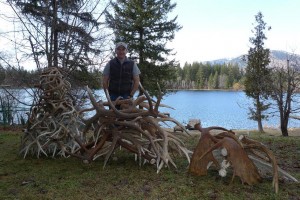Tactics for Shed Hunting

Shed hunting is addicting. The fresh air and wide open spaces of the mountains draws me like a bug to a fluorescent light. Add randomly dropped elk antlers to the mix and it’s a recipe for neglected home projects. It is an activity that can pay off in many ways, including increased fitness and general elk knowledge.
 While shed hunting, I generally hike far enough where most people are not willing to go. This is where the fitness is built. Most days start with snowshoes, extra clothing, food, and water strapped to my pack frame in the early morning twilight. I generally gain 2-3 thousand feet before I slow down and start my search. On most trips, I will be on my feet all day except when I cover ground with my binoculars.
While shed hunting, I generally hike far enough where most people are not willing to go. This is where the fitness is built. Most days start with snowshoes, extra clothing, food, and water strapped to my pack frame in the early morning twilight. I generally gain 2-3 thousand feet before I slow down and start my search. On most trips, I will be on my feet all day except when I cover ground with my binoculars.
I will stop and thoroughly glass openings, hoping to see a tine sticking up or the unmistakable dark curve of a main beam. Between openings, I’ll hike trails in the dark timber and ease through bedding areas. Following these elk trails in the snow has taught me basic animal behavior, biology, and food preferences, and finding bedding areas has shown me how and where elk prefer to relax. This has lead to an increased knowledge of my quarry and increased success in the fall.
Towards evening, hopefully packing a few antlers, I find a fast and efficient route back to the valley floor and the comfort of my truck. Most days my food and water will last the duration of the hike. I try to pack a 100 oz hydration bladder of water along with an extra liter bottle of sports drink to help replace electrolytes. Food is a simple affair of bagels with Nuttella, almonds, and some elk jerky.
 Here are a few general tips to keep in mind while shed hunting:
Here are a few general tips to keep in mind while shed hunting:
- Take some time to learn about your local elk herd. Glass wintering herds from a distance to see how they utilize the terrain and cover.
- Stay in shape so you can put in an honest effort in the spring. Run, cycle, or stair-climb to maintain endurance throughout the winter.
- Learn to read and age sign. Tracks, droppings, and browsed vegetation are key indicators that elk are in the area. Try to determine if the sign was left during the time the elk were shedding and concentrate your efforts there.
- When you are in fresh sign, slow down and scan the area around you methodically. Use your binoculars in the dark timber too.
- Do not pressure or chase animals on their winter range. Remember that as hunters were are true conservationists. Our interests are best served if we are not complicit in the unnecessary death of what we hold dear. Remember that it is just a bone; don’t make it a matter of life or death for the animal.
- Educate yourself and follow the local laws and regulations. Some states have area restrictions and/or shed hunting seasons.
